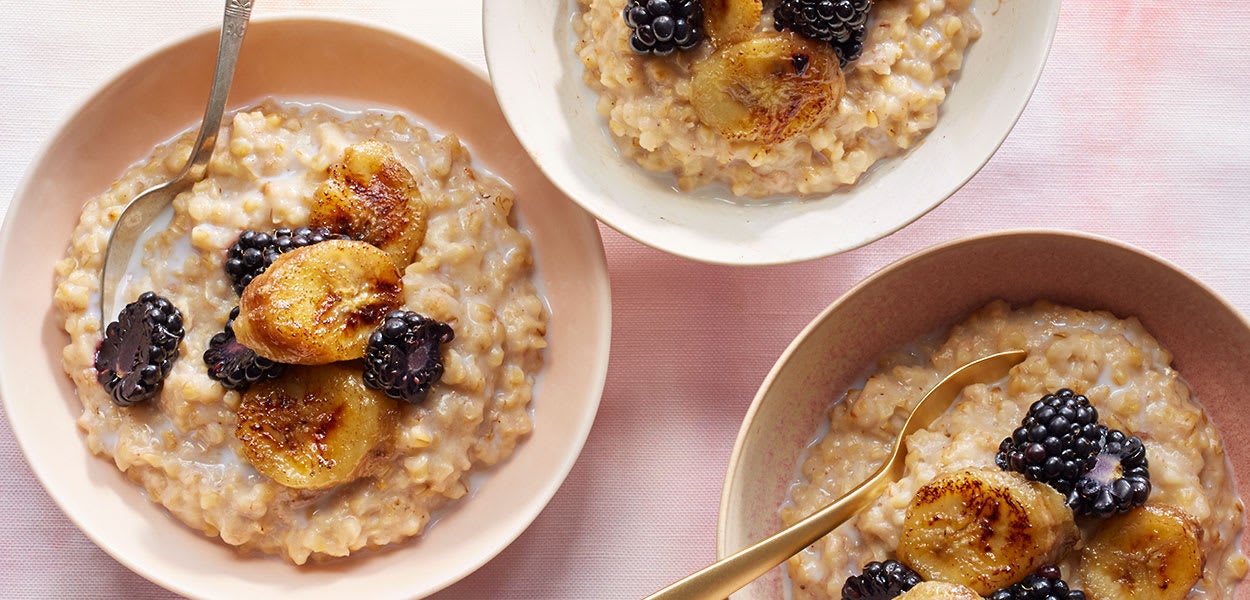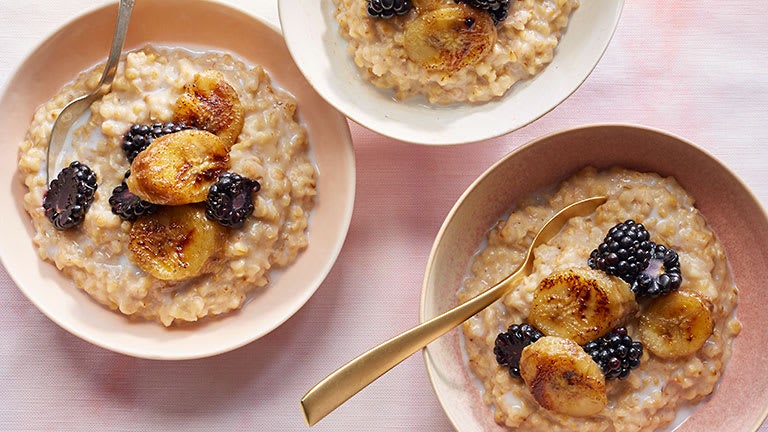11 of the Most Filling Foods to Eat if You’re Always Hungry


One of the most common myths about weight loss? That you need to feel hungry to make it happen. In reality, deprivation is not only unsustainable, but it can also lead to overeating. That’s why staying satisfied is so important. And that means knowing which foods are most filling. Here are 11 of the top dietitian-recommended choices, from potatoes to popcorn.
What to eat to stay full and lose weight
That feeling of satisfaction or fullness after eating is what experts call “satiety.” And not all foods have the same impact. Please see: the satiety index list, which compares how filling a 240-calorie portion is of 38 different foods. In general, high-scoring items (a.k.a. the most filling foods to prevent hunger) have a few things in common:
- High in volume, meaning they have a lot of air or water, which can make portion sizes larger (see: grapes and popcorn).
- High in fiber and protein, “which both play a role in slowing digestion,” according to Michelle Cardel, Ph.D., RD, the senior director of global clinical research and nutrition at WeightWatchers.
- Low in energy density, or in other words, delivers relatively few calories for its weight.
11 of the most filling foods for weight loss
Not all of the most filling foods are nutrient-packed, but many deliver a fair amount of vitamins and minerals per calorie as well. Here are 11 worth adding to your meals and snacks. Each is listed with nutrition information—but WeightWatchers makes your daily math seamless with the Points system, which crunches all the macros into a single, easy-to-track number.
1. Potatoes
1 plain medium baked potato: 4 Points
Rich in water and with 3 grams of fiber and 5 grams of protein per medium potato (4 Points), this simple spud beat 37 other foods to score highest on the satiety index scale. In one study, participants who consumed 45 grams of potatoes reported feeling more satisfied and less hungry compared to those who ate the same amount of rice or pasta. “The skin of a potato contains fullness-supporting fiber, so be sure to eat the skin too, not just the flesh,” Cardel suggests. One note: This fiber-boost is only true for fresh potatoes, not ones that have bruises, eyes, and green spots.
RELATED: Am I really hungry?
2. Oatmeal
1 cup made with water: 3 Points
Prospective short term studies suggest oatmeal consumption helps lower body mass index and body weight. Why? One reason is that oats are rich in soluble fiber, a type of fiber that becomes viscous and gel-like when combined with liquid, says Wendy Bazilian, RD, owner of Bazilian’s Health in San Diego. The oats are thought to impact appetite-reducing hormones, which makes it more likely you’ll eat less, and they empty out of your stomach at a slower rate than refined carbs.
But there’s one important caveat: Because soluble fiber needs liquid to thicken up, oats seem to be the most filling when they’re cooked in water or milk to make oatmeal or eaten with a glass of water.
RELATED: Overnight oats 3 ways
3. Lean proteins
Chicken breast and seafood: ZeroPoint foods
Those who eat 25 to 30 percent of their calories in the form of protein generally eat less and have an easier time maintaining or losing weight compared to those who eat 10 percent or fewer of their calories from protein, according to a 2014 study in The Journal of the Missouri Medical Association. While it’s common to be eating plenty of protein from meat, poultry, and eggs, many people fall short with getting enough protein from seafood, nuts, and seeds. Eating more of those kinds of protein-rich foods can help you get more fiber, unsaturated fat, and vitamin D.
4. Beans
All beans: ZeroPoint foods
Toss them into salad, use them in soup, or puree them into a dip. Adding beans and legumes like chickpeas, black beans, and lentils to a meal increases satiety by an average of 31%, according to a recent scientific review published in the journal Obesity.
When it comes to fullness, these tiny powerhouses seem to pack a one-two punch. They are complex carbohydrates, which deliver energy, and they are rich in fiber. But they also have protein, which takes longer to process—helping you stay satisfied for longer. “It’s a slow, sustained release of blood sugar, which can lengthen satiety,” Bazilian says.
RELATED: A dozen things to do with canned beans
5. Non-starchy vegetables
All non-starchy vegetables: ZeroPoint foods
Veggies like leafy greens, broccoli, cauliflower, asparagus, peppers, and celery have low energy density. That means that they deliver relatively few calories for their serving size—but because they’re high in water and fiber, they have more volume and take up more space in your stomach. “If you choose foods that have a lower density of calories, you’ll get a bigger portion for your calorie needs,” says Barbara Rolls, Ph.D., director of the Laboratory for the Study of Human Ingestive Behavior at Penn State University and author of The Ultimate Volumetrics Diet. Case in point: You’d have to eat more than two cups of cooked baby spinach to consume 100 calories, but you’d get the same amount of calories from just 1 measly tablespoon of butter.
6. Eggs
All eggs: ZeroPoint foods
Have them in the morning, and you just might feel fuller all day long. One study found that women who had overweight reported that they consumed less food for up to 36 hours when they ate eggs for breakfast, compared to when they ate bagels. This could be because eggs are packed with protein (a large egg has 6 grams), which digests at a slower rate than carbohydrate-based foods and help keep you satisfied longer, Bazilian says. But that’s not all. A small study also suggests that eggs could suppress the production of the hunger hormone ghrelin, making you feel less hungry.
RELATED: 25 unique egg recipes
7. Fruit
All fruit: ZeroPoint foods for members without diabetes
Loaded with water and fiber, apples, oranges, bananas, and grapes all rated as above average on the satiety index. Plus, they’re versatile (please see banana ice cream and peanut butter and apple snack rings!) and easy to eat on-the-go.
For the maximum satisfaction per snack, Cardel recommends pairing your favorite piece of fruit with a source of protein, such as nuts or cheese. And if possible, consume it in whole fruit form — canned or frozen works too — rather than via fruit juice, which is fiber-free and, as a result, less filling.
RELATED: ZeroPoint Cheat Sheet: Fruit
8. Greek yogurt
Nonfat, plain Greek yogurt: ZeroPoint food
A cup of Greek yogurt delivers around 22g of protein, which can help reduce the desire to eat and keep you feeling full for longer. What’s more, it’s relatively high in water, which adds volume. Combined, those two things will keep you satisfied, Bazilian says.
Of course, not all yogurts are created equal. Plain yogurt is a better choice than the flavored stuff, since it’s free of added sugars which, in excess, have been linked to increased risk for certain health conditions.
RELATED: Taste test: The best non-fat plain yogurt
9. Brothy soup
1 cup of minestrone: 2 Points
Like non-starchy vegetables, soups have a low-calorie density—all that liquid will help fill you up for relatively few calories, Rolls says.
The key is sticking with broth- or veggie-based soups, like minestrone or butternut squash, instead of creamy ones. If your soup is main part of a meal, add a source of lean protein like shredded chicken to give it even more staying power, Rolls says.
RELATED: Thermos soups, 5 ways
10. Nuts
1oz of almonds: 4 Points
1oz of walnuts: 6 Points
“Nuts and nut butters provide a trifecta of protein, fiber, and heart-healthy fats, all of which can help to support feelings of fullness,” Cardel says. And while the satiety index only looked at peanuts, scientists have found that walnuts and almonds are the real winners when it comes to preventing hunger.
While portion sizes are smaller for nuts than they are for, say, fruits or veggies, they’re still worth incorporating into meals and snacks. Exhibit A is a 2021 study in the journal Nutrients, which found that participants felt more full after eating 1½ ounces of mixed nuts than they did after snacking on the same amount of pretzels. The nut-noshers also displayed lower heart rates; a sign of a possible heart health boost. That said, both groups were on a controlled-calorie diet and lost the same amount of weight.
11. Popcorn
Air-popped: ZeroPoint food
For one of the most filling low-calorie foods out there, get popping. “As a whole grain, popcorn provides fiber, which can help to support fullness,” says Cardel. It is also a ZeroPoint food as long as it’s air-popped and doesn’t have butter on top.
In one study, participants who snacked on 100 calories of popcorn (6 cups) reported lower levels of hunger and higher levels of satisfaction than those who had 150 calories of potato chips (1 cup).
To keep calories and fat in check, aim for air-popped varieties rather than the butter-bathed movie theater styles or sugar-coated kettle corn. Learn more about the best types of popcorn to eat on WeightWatchers.
Reviewed by Zoe Griffiths, R.D., October 2019
Some foods are naturally more filling than others. In general, foods that are higher in fiber and protein as well as those with more volume will help you feel more full than other foods. By incorporating foods like popcorn, fruit, nuts, lean proteins, and potatoes into your meals and snacks, you can up your satisfaction for longer.